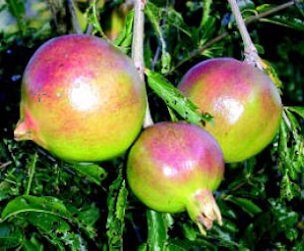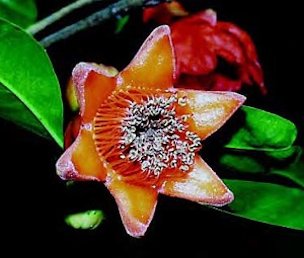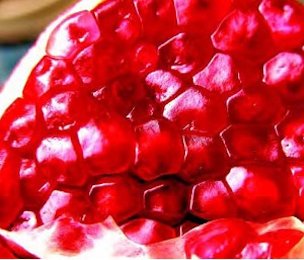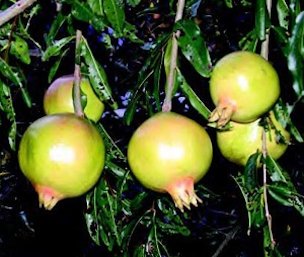From the Twelve
Fruits With Potential Value-Added and Culinary Uses
by Ken Love, Richard Bowen, and Kent Fleming
Pomegranate
Scientific
name: Punica granatum L.
Family: Punicaceae
Origin: Iran, Afghanistan, India

One
of the earliest cultivated fruits, mentioned in ancient Egyptian
mythology, the pomegranate is steeped in history and tradition. Early
travelers carried the fruit throughout the Middle East and Northern
Africa. The fruit became the symbol of the lands of Armenia. Eating
pomegranate was said to “purge the system of envy and
hatred.” Recent worldwide popularity of the fruit and its juice
is due to the health benefits from antioxidants in the fruit.
Spanish
settlers first reported pomegranate in California in 1769. The fruit is
commonly referred to as grenade or granada or by the Persian names
dulim or dulima. In Japanese the fruit is called zakuro, and it is
sometimes sold under that name in Hawai‘i. Dr. F.J.F. Meyen first
observed it in Hawai‘i in 1825, and Hiram Bingham reported it for
sale in a Honolulu market in 1831.
Cultivars
There
are hundreds of known pomegranate varieties. The USDA germplasm
repository in Davis, California, has 189 accessions from many parts of
the world. Pomegranates can be divided into four groups based on skin
color: dark red, yellow-green, black-violet, and white. Plants do not
come true from seed, and therefore seedling trees in Hawai‘i are
highly variable in quality. Compared to cultivated varieties, seedling
trees often have larger seeds that make up over half of the
fruit’s weight. In India, the seeds are used for culinary
purposes, and some varieties reflect this by having 70 percent of the
fruit weight being seeds. A cultivar from California named
‘Wonderful’ is found in Hawai‘i.
‘Grenada’, a patented variety that matures a month earlier
than ‘Wonderful’, is also found here.

Pomegranate flower
Environment
Pomegranate
trees tolerate a wide range of soils and are very tolerant of drought.
Irrigation is used to guarantee fruit production, as trees will not
flower in extended periods of drought.
Trees are spaced 15–20
feet apart in commercial orchards. Generally, 20-foot spacing is used
in large orchards to facilitate weeding and field maintenance. Wide
spacing and planting in full sun allows enough light to reach the fruit
to ensure coloration.

The red flesh covering the seeds is the edible portion
Horticulture
Pomegranate
requires an active pruning regime for the first 3 years in the field.
After planting, the low side shoots should be cut off to leave one or
more trunks. The tree is a vigorous grower, with many root shoots and
suckers that should be removed, as they generally do not bear fruit,
and they grow rapidly at the expense of fruiting wood. Fruit forms only
at the tips of new growth. Branches should be shortened to encourage
new shoots, and the tree should be kept low to facilitate harvesting.
Fertilizer is generally applied in fall or winter, with 1⁄2 pound
of nitrogen followed by 1⁄4 pound of 6-66 organic fertilizer in
spring for young trees. The trees reach full production in 5–6
years. Some producing trees in the Middle East are reported to be 200
years old.
Pests and
diseases
Pomegranate can suffer foliar damage from whitefly (Aleurodicus sp.),
thrips (Selenothrips
sp.), mealybugs (Pseudococcus
sp.), and scale (Ceroplastes
sp.).
Wet fruit rot (Phomopsis
sp.) can occur at the base of the fruit. Removing and disposing of
affected fruit is advisable to prevent spread of the fungus. Fruit rot
from Botrytis cinerea can occur after harvest from improper storage.
The
hard shell of the fruit prevents damage from a number of insects, but
the base of the fruit, the calyx, and the stamen cluster can be home to
ants, roaches, and other pests. Some growers will cut the stamen
cluster off half-way through the growing cycle to prevent infestation.
In Asia, it is common to use protective wrapping or fruit bags on
pomegranate once the fruit is set. This helps to prevent damage from
pests and diseases. It also helps produce even fruit coloration.
Propagation
Pomegranates
are commercially propagated from hardwood cuttings 10–20 inches
long, treated with a rooting hormone used to ensure development.
Air-layers are also possible. Seeds germinate easily but often produce
unreliable results. Grafting is seldom successful.
Harvesting
and yield
Fruit
ripens 6–7 months after flowering but will crack if left too long
on the tree. Generally, fruits are harvested once they turn color and
before yellowing appears at the base.
The fruit does not continue to
ripen once harvested, and timing can be critical in commercial
orchards. Growers in Israel and California tap the fruit, listening for
a metallic sound that tells them it is time to harvest. Strong stems
make it necessary for the fruit to be cut from the tree and not pulled
off by hand. Mature, healthy trees can produce 100–200 fruits.
Kona trees at 400 feet elevation produce three to five fruits per week
throughout the year when irrigated. An older tree at 1800 feet
elevation in South Kona produced more than 200 fruits from July through
December.

Immature fruits
Postharvest
quality
The
pomegranate has a long storage life, more than 7 months when held at
32–41°F and 80–85% relative humidity. The fruit is
susceptible to chilling injury and browning if stored below freezing.
Packaging,
pricing, and marketing
In
production areas in California, the fruit is packed in boxes by size
with the calyx or stamen end up, often in molded plastic trays to
prevent bruising. In Hawai‘i, the fruit is often sold at autumn
farmers’ markets in boxes. It is also sold to hotel chefs, who
prefer fresh, locally grown pomegranates to treated imports. Wholesale
prices run from $2.00 to $2.50 per pound. Fruits sold at farmers’
markets on the Big Island sell for $0.50 to $2.00 each, based on size.
Food uses and
nutrition
Pomegranate
juice can help prevent hardening (arteriosclerosis) of the carotid
arteries. The seeds, which are used as a spice in India, are high in
fiber. The fruit is high in antioxidants including phenolic compounds
and anthocyanins.


|
Recipe:
Pomegranate syrup on pineapple banana sorbet
Kalani Adams
24 cups sugar
6 split Hawai‘i vanilla beans
6 pineapples
12 ripe bananas
6 T pomegranate syrup
4 cups water
Peel, core, and trim pineapple. Peel bananas.
In
medium saucepan, dissolve sugar in 4 cups of water over moderately high
heat. Add vanilla bean and let mixture infuse until cool. Pass though
chinois to remove any solids.
Puree pineapple and banana in a food
processor. Add sugar mixture and process just until mixed. Stir in
pomegranate syrup. Pour mixture into ice cream maker and freeze until
firm. Drizzle additional pomegranate syrup before serving.
Makes 48 servings.
|
About the Twelve Fruits
With Potential Value-Added and Culinary Uses Project
Back to
Pomegranate Page
|
© 2007, University of Hawai'i
|
Bibliography
Love, Ken, et al. "Pomegranate." Twelve
Fruits With Potential Value-Added and Culinary
Uses,
University of Hawai'i at Mānoa, College of
Tropical Agriculture and Human Resources, 2007, www.hawaiifruit.net/12trees.html.
Accessed 29
Dec. 2015.
Photographs
Love, Ken. "Pomegranate." Twelve Fruits With Potential Value-Added and Culinary
Uses, University of Hawai'i at Mānoa, College of Tropical
Agriculture and Human
Resources, 2007, HawaiiFruit.net, www.hawaiifruit.net/12trees.html. Accessed 9 Mar. 2016.
Published 29
Dec. 2015 LR. Last update 9 Mar. 2016 LR
|

